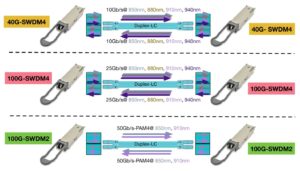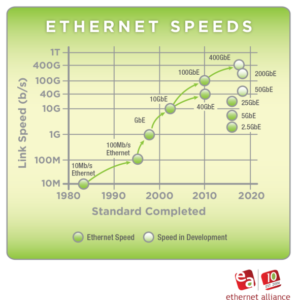Applications Presently Using SWDM
Factoring that fiber infrastructure costs, parallel multimode MPO cabling is largely more costly than LC-duplex fiber patch cords. For direct port-to-port connections, it’s more desirable to use a single fiber pair instead of MPO trunk to keep costs down.
For supporting smooth migration from 10G to 40G Ethernet, Cisco released a proprietary 40G bi-directional (BiDi) transceiver solution that allows reuse of the duplex multimode fiber pair for 40G connection. The BiDi transceiver utilizes two wavelengths (850nm and 900nm) transmitting in the same fiber on opposite directions, with an actual bit rate of 20 Gbps. It supports 40G data transmission up to 150m in OM4 multimode fiber.
Arista’s 40G universal transceiver is another solution that supports LC-duplex fiber pair instead of MPO. The 40GBASE-UNIV supports a reach of 500m singlemode fiber and 150m reach in OM4. Similar solutions are also available from Juniper (40G-LX4) and Finisar (40G-LM4).
In short-reach datacom applications, BiDi and Universal transceiver solutions have proven to be market successes.
New SWDM Applications in WBMMF
Historically, compared to singlemode transceivers, multimode transceivers cost less and are more efficient in power consumption. The introduction of wideband multimode fiber will maintain the appeal of multimode fiber cabling systems for next-generation Ethernet speed implementation with SWDM technology.
Since 40G Ethernet was introduced, QSFP has become the most popular form factor for 40G and 100G Ethernet physical interfaces. Recently, new SWDM-based QSFP multimode transceivers, including 40G-SWDM4, 100G-SWDM4 and 100G-SWDM2, have been demonstrated by a few vendors.
In regard to standardization, the SWDM4 consortium built a consensus that 4-wavelength is a viable solution, and it’s possible to support up to eight wavelengths in the single MMF. In the IEEE 802.3 working group, WBMMF was already taken into consideration for new standards development.
If you opt for SWDM transceivers in your next data center deployment, we recommend taking a close look at OM5 to support desired reach and link performance.
Read full article





